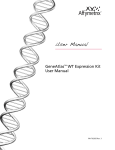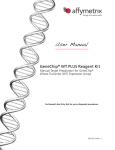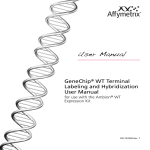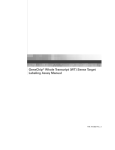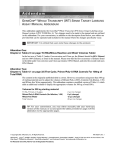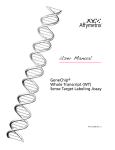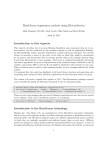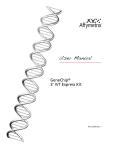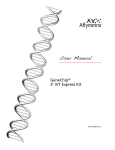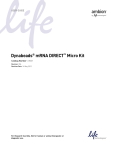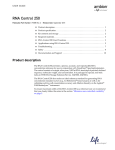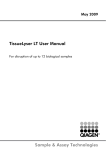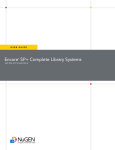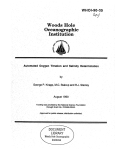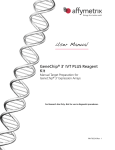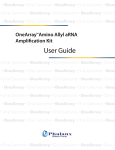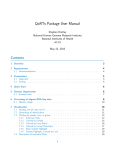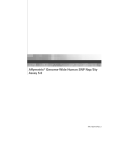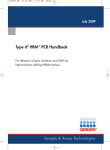Download Ambion® WT Expression Kit - Thermo Fisher Scientific
Transcript
USER GUIDE Ambion® WT Expression Kit for use with: Affymetrix® GeneChip® Whole Transcript (WT) Expression Arrays Publication Part Number 4425209 Rev. D Revision Date August 2011 For Research Use Only. Not intended for any animal or human therapeutic or diagnostic use. Information in this document is subject to change without notice. APPLIED BIOSYSTEMS DISCLAIMS ALL WARRANTIES WITH RESPECT TO THIS DOCUMENT, EXPRESSED OR IMPLIED, INCLUDING BUT NOT LIMITED TO THOSE OF MERCHANTABILITY OR FITNESS FOR A PARTICULAR PURPOSE. TO THE FULLEST EXTENT ALLOWED BY LAW, IN NO EVENT SHALL APPLIED BIOSYSTEMS BE LIABLE, WHETHER IN CONTRACT, TORT, WARRANTY, OR UNDER ANY STATUTE OR ON ANY OTHER BASIS FOR SPECIAL, INCIDENTAL, INDIRECT, PUNITIVE, MULTIPLE OR CONSEQUENTIAL DAMAGES IN CONNECTION WITH OR ARISING FROM THIS DOCUMENT, INCLUDING BUT NOT LIMITED TO THE USE THEREOF, WHETHER OR NOT FORESEEABLE AND WHETHER OR NOT APPLIED BIOSYSTEMS IS ADVISED OF THE POSSIBILITY OF SUCH DAMAGES. NOTICE TO PURCHASER: LIMITED LICENSE Limited Use Label License: Research Use Only The purchase of this product conveys to the purchaser the limited, non-transferable right to use the purchased amount of the product only to perform internal research for the sole benefit of the purchaser. No right to resell this product or any of its components is conveyed expressly, by implication, or by estoppel. This product is for internal research purposes only and is not for use in commercial applications of any kind, including, without limitation, quality control and commercial services such as reporting the results of purchaser’s activities for a fee or other form of consideration. For information on obtaining additional rights, please contact [email protected] or Out Licensing, Life Technologies, 5791 Van Allen Way, Carlsbad, California 92008. End Users are specifically not authorized to and are forbidden from reselling, transferring or distributing any products either as a stand alone product or as a component of another product. This product or portions thereof is manufactured and sold under license from GE Healthcare. End User Terms And Conditions Acceptance. These terms and conditions shall govern the purchase, use, transfer and acceptance of the products described in the purchase order, quotation or invoice, which products are sold and distributed by Applera Corporation to the buyer/transferee of such products (the "End User"). The transfer/sale of products to the End User is expressly conditional upon End User's acceptance of these terms and conditions. Restrictions on Use. End Users are specifically not authorized to and are forbidden from reselling, transferring or distributing any products either as a stand along product or as a component of another product. The right to use the products does not, in and of itself, include or carry any right of the End User to any GE Healthcare Bio-Sciences Corp.'s technology or intellectual property other than expressly provided herein. End Users may not attempt to reverse engineer parameters of any of GE Healthcare Bio-Sciences Corp. proprietary products or services. DISCLAIMER OF WARRANTIES. GE HEALTHCARE BIO-SCIENCES CORP. PROVIDES NO WARRANTIES TO END USER (STATUTORY OR IMPLIED), INCLUDING WITHOUT LIMITATION, AS TO PRODUCT QUALITY, CONDITION, DESCRIPTION, MERCHANTABILITY OR FITNESS FOR A PARTICULAR PURPOSE, AND ALL SUCH WARRANTIES ARE HEREBY EXPRESSLY DISCLAIMED. GE HEAL THCARE BIO-SCIENCES CORP. HEREBY EXPRESSLY DISCLAIMS ANY WARRANTY REGARDING RESULTS OBTAINED THROUGH THE USE OF THE PRODUCTS, INCLUDING WITHOUT LIMITATION ANY CLAIM OF INACCURATE, INVALID OR INCOMPLETE RESULTS. Exclusion of Liability. GE Healthcare Bio-Sciences Corp. and its affiliates shall have no liability to an End User, including, without limitation, for any loss of use or profits, business interruption or any consequential, incidental, special or other indirect damages of any kind, regardless of how caused and regardless of whether an action in contract, tort, strict product liability or otherwise. TRADEMARKS The trademarks mentioned herein are the property of Life Technologies Corporation or their respective owners. NanoDrop is a registered trademark of NanoDrop Technologies LLC. Agilent and Bioanalyzer are trademarks of Agilent Technologies, Inc. Affymetrix and GeneChip are registered trademarks of Affymetrix, Inc. © 2011 Life Technologies Corporation. All rights reserved. Part Number 4425209 Rev. D August 2011 Contents About This Guide . . . . . . . . . . . . . . . . . . . . . . . . . . . . . . . . . . . . . . . . . . . . . . . . . 5 Purpose . . . . . . . . . . . . . . . . . . . . . . . . . . . . . . . . . . . . . . . . . . . . . . . . . . . . . . . . . . . . . . . . . . . . . . . . . . . . . 5 User attention words . . . . . . . . . . . . . . . . . . . . . . . . . . . . . . . . . . . . . . . . . . . . . . . . . . . . . . . . . . . . . . . . . . 5 ■ Ambion® WT Expression Kit . . . . . . . . . . . . . . . . . . . . . . . . . . . . . . . . . . . . . 7 Product information . . . . . . . . . . . . . . . . . . . . . . . . . . . . . . . . . . . . . . . . . . . . . . . . . . . . . . . . . . . . . . . . . . . 7 Purpose of the product . . . . . . . . . . . . . . . . . . . . . . . . . . . . . . . . . . . . . . . . . . . . . . . . . . . . . . . . . . . . 7 Kit contents and storage . . . . . . . . . . . . . . . . . . . . . . . . . . . . . . . . . . . . . . . . . . . . . . . . . . . . . . . . . . 8 Required materials . . . . . . . . . . . . . . . . . . . . . . . . . . . . . . . . . . . . . . . . . . . . . . . . . . . . . . . . . . . . . . . . . . . 9 Equipment . . . . . . . . . . . . . . . . . . . . . . . . . . . . . . . . . . . . . . . . . . . . . . . . . . . . . . . . . . . . . . . . . . . . . . 9 Reagents and supplies . . . . . . . . . . . . . . . . . . . . . . . . . . . . . . . . . . . . . . . . . . . . . . . . . . . . . . . . . . . . 9 Day 1 workflow . . . . . . . . . . . . . . . . . . . . . . . . . . . . . . . . . . . . . . . . . . . . . . . . . . . . . . . . . . . . . . . . . . . . . . 10 Day 2 workflow . . . . . . . . . . . . . . . . . . . . . . . . . . . . . . . . . . . . . . . . . . . . . . . . . . . . . . . . . . . . . . . . . . . . . . 11 Day 2 workflow, continued . . . . . . . . . . . . . . . . . . . . . . . . . . . . . . . . . . . . . . . . . . . . . . . . . . . . . . . . . . . . 12 Procedure . . . . . . . . . . . . . . . . . . . . . . . . . . . . . . . . . . . . . . . . . . . . . . . . . . . . . . . . . . . . . . . . . . . . . . . . . . Implement a plan to maintain procedural consistency . . . . . . . . . . . . . . . . . . . . . . . . . . . . . . . . Equipment and reagent preparation . . . . . . . . . . . . . . . . . . . . . . . . . . . . . . . . . . . . . . . . . . . . . . . Prepare the Control RNA and total RNA . . . . . . . . . . . . . . . . . . . . . . . . . . . . . . . . . . . . . . . . . . . . Prepare the Poly-A RNA Controls . . . . . . . . . . . . . . . . . . . . . . . . . . . . . . . . . . . . . . . . . . . . . . . . . . Evaluate RNA quality . . . . . . . . . . . . . . . . . . . . . . . . . . . . . . . . . . . . . . . . . . . . . . . . . . . . . . . . . . . . Evaluate RNA integrity . . . . . . . . . . . . . . . . . . . . . . . . . . . . . . . . . . . . . . . . . . . . . . . . . . . . . . . . . . . Synthesize first-strand cDNA . . . . . . . . . . . . . . . . . . . . . . . . . . . . . . . . . . . . . . . . . . . . . . . . . . . . . Synthesize second-strand cDNA . . . . . . . . . . . . . . . . . . . . . . . . . . . . . . . . . . . . . . . . . . . . . . . . . . Synthesize cRNA by In Vitro Transcription . . . . . . . . . . . . . . . . . . . . . . . . . . . . . . . . . . . . . . . . . . Purify cRNA . . . . . . . . . . . . . . . . . . . . . . . . . . . . . . . . . . . . . . . . . . . . . . . . . . . . . . . . . . . . . . . . . . . . Assess cRNA yield and size distribution . . . . . . . . . . . . . . . . . . . . . . . . . . . . . . . . . . . . . . . . . . . . Synthesize 2nd-cycle cDNA . . . . . . . . . . . . . . . . . . . . . . . . . . . . . . . . . . . . . . . . . . . . . . . . . . . . . . Hydrolyze using RNase H . . . . . . . . . . . . . . . . . . . . . . . . . . . . . . . . . . . . . . . . . . . . . . . . . . . . . . . . Purify 2nd-cycle cDNA . . . . . . . . . . . . . . . . . . . . . . . . . . . . . . . . . . . . . . . . . . . . . . . . . . . . . . . . . . . Assess cDNA yield and size distribution . . . . . . . . . . . . . . . . . . . . . . . . . . . . . . . . . . . . . . . . . . . . Fragment and label the single-stranded cDNA . . . . . . . . . . . . . . . . . . . . . . . . . . . . . . . . . . . . . . 13 13 13 14 15 17 17 17 19 20 20 22 23 25 25 27 28 Troubleshooting . . . . . . . . . . . . . . . . . . . . . . . . . . . . . . . . . . . . . . . . . . . . . . . . . . . . . . . . . . . . . . . . . . . . . 28 Ambion® WT Expression Kit User Guide 3 Contents ■ APPENDIX Safety . . . . . . . . . . . . . . . . . . . . . . . . . . . . . . . . . . . . . . . . . . . 31 Chemical safety . . . . . . . . . . . . . . . . . . . . . . . . . . . . . . . . . . . . . . . . . . . . . . . . . . . . . . . . . . . . . . . . . . . . . . 32 Biological hazard safety . . . . . . . . . . . . . . . . . . . . . . . . . . . . . . . . . . . . . . . . . . . . . . . . . . . . . . . . . . . . . . . 33 Bibliography . . . . . . . . . . . . . . . . . . . . . . . . . . . . . . . . . . . . . . . . . . . . . . . . . . . 35 4 Ambion® WT Expression Kit User Guide About This Guide CAUTION! ABBREVIATED SAFETY ALERTS. Hazard symbols and hazard types specified in procedures may be abbreviated in this document. For the complete safety information, see the “Safety” appendix in this document. IMPORTANT! Before using this product, read and understand the information the “Safety” appendix in this document. Purpose The Ambion® WT Expression Kit User Guide provides detailed information for preparing RNA samples for Affymetrix whole transcriptome microarray analysis using the Ambion® WT Expression Kit. User attention words Five user attention words appear in this document. Each word implies a particular level of observation or action as described below: Note: Provides information that may be of interest or help but is not critical to the use of the product. IMPORTANT! Provides information that is necessary for proper instrument operation or accurate chemistry kit use. CAUTION! Indicates a potentially hazardous situation that, if not avoided, may result in minor or moderate injury. It may also be used to alert against unsafe practices. WARNING! Indicates a potentially hazardous situation that, if not avoided, could result in death or serious injury. DANGER! Indicates an imminently hazardous situation that, if not avoided, will result in death or serious injury. Except for IMPORTANTs, the safety alert words in user documentation appear with an open triangle figure that contains a hazard symbol. These hazard symbols are identical to the hazard symbols that are affixed to the instrument. See the “Safety” appendix for descriptions of the symbols. Ambion® WT Expression Kit User Guide 5 About This Guide User attention words 6 Ambion® WT Expression Kit User Guide Ambion® WT Expression Kit Product information Purpose of the product The Ambion® WT Expression Kit enables you to prepare RNA samples for Affymetrix whole transcriptome microarray analysis. The kit generates sense-strand cDNA from total RNA for fragmentation and labeling using the Affymetrix GeneChip® WT Terminal Labeling Kit (Part no. 900671). The kit is optimized for use with human, mouse, and rat Affymetrix GeneChip® Sense Target (ST) Arrays. The WT Expression Kit uses a reverse transcription priming method that specifically primes non-ribosomal RNA from your sample, including both poly(A) and nonpoly(A) mRNA. Primers that avoid rRNA binding are designed by using a proprietary-oligonucleotide matching algorithm. These primer sequences provide complete and unbiased coverage of the transcriptome while significantly reducing the priming of rRNA. Ambion® WT Expression Kit User Guide 7 Ambion® WT Expression Kit Product information Kit contents and storage For manual use only For high-throughput automated use only 10-Reaction kit (Part no. 4411973) 30-Reaction kit (Part no. 4411974) 24-Reaction kit (Part no. 4440537) 96-Reaction kit (Part no. 4440536) Storage First-Strand Enzyme Mix 11 µL 33 µL 50 µL 150 µL –20°C First-Strand Buffer Mix 44 µL 132 µL 160 µL 600 µL –20°C Second-Strand Enzyme Mix 55 µL 165 µL 175 µL 650 µL –20°C 138 µL 413 µL 400 µL 1.45 mL –20°C 66 µL 198 µL 210 µL 850 µL –20°C 264 µL 792 µL 750 µL 1.40 mL –20°C 10 µL 10 µL 10 µL 10 µL –20°C Nuclease-free Water 1.75 mL 1.75 mL NA NA any temp† 2nd-Cycle Buffer Mix 88 µL 264 µL 425 µL 1.45 mL –20°C Random Primers 22 µL 66 µL 100 µL 300 µL –20°C 2nd-Cycle Enzyme Mix 88 µL 264 µL 275 µL 1.00 mL –20°C RNase H 22 µL 66 µL 100 µL 300 µL –20°C Nucleic Acid Binding Buffer Concentrate 1.1 mL 3.3 mL 3.5 mL 12.5 mL room temp Nucleic Acid Binding Beads 220 µL 660 µL 700 µL 2.5 mL 4°C‡ Component Second-Strand Buffer Mix IVT Enzyme Mix IVT Buffer Mix Control RNA (1 mg/mL HeLa total RNA) Nucleic Acid Purification Reagents Nucleic Acid Wash Solution Concentrate 10 mL 20 mL 15 mL 50 mL room temp 5 mL 5 mL 6 mL 22 mL 4°C or room temp 10 mL 10 mL NA NA room temp 10 40 NA NA room temp U-Bottom Plate 2 4 NA NA room temp Reservoir 1 2 NA NA room temp Elution Solution Nuclease-free Water Consumables 8-Strip PCR Tubes & Caps (0.2-mL) † Store the Nuclease-free Water at –20°C, 4°C, or room temp. ‡ Do not freeze. 8 Ambion® WT Expression Kit User Guide Ambion® WT Expression Kit Required materials Required materials Equipment Item Source Agilent 2100 Bioanalyzer Agilent Technologies, Inc. Ambion Magnetic Stand-96 Life Technologies Part no. AM10027 Applied Biosystems Veriti® 96-Well Thermal Cycler Life Technologies Part no. 4375786 Barnstead Titer Plate Shaker, Barnstead/LabLine Major Laboratory Supplier (MLS) Thermo Scientific NanoDrop® ND-8000 UV-Vis Spectrophotometer NanoDrop Technologies or Thermo Scientific NanoDrop® ND-1000 UV-Vis Single-Channel Spectrophotometer Microcentrifuge with adapter for PCR 8-strip tubes or for 96-well plates Reagents and supplies MLS Item Source GeneChip® WT Terminal Labeling and Controls Kit. (For a list of kit components, go to: www.affymetrix.com and search for Ambion WT Expression Kit.) Affymetrix Part no. 901524 (30 reaction) Affymetrix Part no. 901525 (10 reaction) (Optional) Quant-iT™ RiboGreen® RNA Reagent Life Technologies (Optional) Quant-iT™ PicoGreen® RNA Reagent Life Technologies 100% Ethanol (ACS grade or equivalent) MLS† 100% Isopropanol (ACS grade or equivalent) MLS† RNA 6000 Nano Kit Agilent Technologies, Inc. Part no. 5067-1511 (Optional) RNaseZap® RNase Decontamination Solution Life Technologies Part no. AM9780 (250 mL) Life Technologies Part no. AM9784 (4.0 L) (Optional) The RNA Storage Solution Life Technologies Part no. AM7000 (10×1.0 mL) Life Technologies Part no. AM7001 (50 mL) † For the MSDS of any chemical not distributed by Life Technologies, contact the chemical manufacturer. Before handling any chemicals, refer to the MSDS provided by the manufacturer, and observe all relevant precautions. Ambion® WT Expression Kit User Guide 9 Ambion® WT Expression Kit Day 1 workflow Day 1 workflow Synthesize first-strand cDNA Prepare the First-Strand Master Mix Total RNA 5´- -3´ 3´- Add the total RNA Incubate NNN- T7 Promoter -5´ T7 Promoter 5´3´- -3´ NNN- T7 Promoter -5´ Synthesize second-strand cDNA Prepare the Second-Strand Master Mix and add to sample cDNA 3´- -5´ • DNA Polymerase • RNase H Incubate dscDNA 5´3´- -3´ -5´ Synthesize cRNA using in vitro transcription Prepare the IVT Master Mix and add to secondstrand cDNA sample dscDNA 5´3´- -3´ -5´ T7 RNA Polymerase Incubate for 16 hours Antisense cRNA 3´- -5´ Stopping point 10 Ambion® WT Expression Kit User Guide Ambion® WT Expression Kit Day 2 workflow Day 2 workflow Purify cRNA Prepare the cRNA Binding Mix and add to each sample Antisense cRNA 3´- -5´ Nucleic Acid Binding Beads Add 100% isopropanol to each sample and shake gently Enzyme, salt, phosphates, unincorporated dNTP 3´- -5´ Capture the Nucleic Acid Binding Beads and discard the supernatant Wash twice with Nucleic Acid Wash Solution Elute cRNA with preheated Elution Solution Place the cRNA on ice briefly, or freeze immediately Use 1.5 µL of cRNA to assess yield by UV absorbance A240-290/A290 Ratio Assess cRNA yield and size distribution Use 1 µL of cRNA to assess size distribution Frequency (nm) Synthesize 2nd-cycle cDNA Combine 10 µg of cRNA and the Random Primers Antisense cRNA 3´- -5´ • Random Primers (dN6) • dUTP/dNTP mix Incubate Prepare the 2nd-Cycle Master Mix on ice and add to each sample 5´3´- -3´ dUTP NN -5´ NNN Incubate Ambion® WT Expression Kit User Guide 11 Ambion® WT Expression Kit Day 2 workflow, continued Day 2 workflow, continued Hydrolyze using RNase H Add RNase H to the 2nd-Cycle cDNA Antisense cRNA 5´3´- -5´ -5´ Incubate RNase H cDNA 3´- -5´ Optional stopping point Purify 2nd-cycle cDNA Prepare the cDNA Binding Mix, add to each sample, and transfer to a U-bottom plate cDNA 3´- -5´ Nucleic Acid Binding Beads Add ethanol to each sample and shake gently Enzyme, salt, phosphates, unincorporated dNTP 3´- -5´ Capture the Nucleic Acid Binding Beads and discard the supernatant Wash twice with Nucleic Acid Wash Solution Elute the cDNA with preheated Elution Solution Place the cDNA on ice briefly, or freeze immediately Assess cDNA yield and size distribution (Optional) Use 1 µL of cDNA to assess size distribution A240-290/A290 Ratio Determine cDNA yield by UV absorbance Frequency (nm) Fragment and label the single-stranded cDNA For instructions on how to fragment the singlestranded cDNA, refer to the Affymetrix GeneChip® WT Terminal Labeling and Hybridization User Manual (Part no. 702880). cDNA 3´- -5´ -5´ 3´3´- • UDG • APE1 -5´ • TdT • DLR Label 5´5´- 12 Ambion® WT Expression Kit User Guide Ambion® WT Expression Kit Procedure Procedure Implement a plan to maintain procedural consistency To minimize sample-to-sample variation that is caused by subtle procedural differences in gene expression assays, consider implementing a detailed procedural plan. The plan standardizes the variables in the procedure and should include the: • Method of RNA isolation • Amount of input RNA that is used for each tissue type • Type of thermal cycler that is used • Workflow stopping points Equipment and reagent preparation Recommended thermal cycler Life Technologies recommends using the Applied Biosystems Veriti® 96-Well Thermal Cycler with 0.2-mL sample wells (Part no. 4375786) to prepare samples using the Ambion® WT Expression Kit. If you use a different instrument, make sure that the heated cover of your thermal cycler either tracks the temperature of the thermal cycling block or supports specific temperature programming. Program the thermal cycler When using the Applied Biosystems Veriti® Thermal Cycler, set the idle temperature for the heated lid to 50°C prior to starting Day 1, first-strand cDNA synthesis. Maintain this setting throughout Day 1. Prior to starting Day 2, 2nd-cycle cRNA denaturation, change the idle temperature for the lid to 75°C. Maintain this setting throughout Day 2. Prior to starting cDNA fragmentation, change the idle temperature for the lid to 105°C, which ensures that the temperature of the heated lid is at or near the required temperature for each step. For instructions on how to change the temperature settings of the Veriti thermal cycler, refer to the Applied Biosystems Veriti® Thermal Cycler User Guide (Part no. 4375799). An alternate protocol may be used for thermal cyclers that lack a programmable heated lid. This is not the preferred method. Yields of cRNA may be greatly reduced if a lid heated to 105°C is used during the Second-Strand cDNA Synthesis or during the In Vitro Transcription cRNA Synthesis steps. We recommend leaving the heated lid open during Second-Strand cDNA Synthesis. A small amount of condensation will form during the incubation. This is expected, and should not significantly decrease cRNA yields. For In Vitro Transcription cRNA Synthesis, we recommend incubating the reaction in a 40°C hybridization oven if a programmable heated lid thermal cycler is unavailable. Incubation temperatures and times are critical for effective RNA amplification. Use properly calibrated thermal cyclers and adhere closely to the incubation times. Ambion® WT Expression Kit User Guide 13 Ambion® WT Expression Kit Procedure Note: Concentration fluctuations that are caused by condensation can affect your yield. Ensure that the heated lid feature of the thermal cycler is working properly. Table 1 Thermal cycling methods Method First-Strand cDNA Synthesis Heated lid temp. 50°C Alternate Protocol† Step 1 Step 2 Step 3 105°C 25°C, 60 min 42°C, 60 min 4°C, 2 min Lid open 16°C, 60 min 65°C, 10 min 4°C, 2 min Step 4 — Second-Strand cDNA Synthesis RT or disable In Vitro Transcription cRNA Synthesis 50°C 40°C oven 40°C, 16 hrs 4°C, Hold 2nd-Cycle cRNA Denaturation 75°C 105°C 70°C, 5 min 25°C, 5 min 4°C, 2 min 2nd-Cycle cDNA Synthesis 75°C 105°C 25°C, 10 min 42°C, 90 min 70°C, 10 min 4°C, 2 min RNase H Hydrolysis 75°C 105°C 37°C, 45 min 95°C, 5 min 4°C, 2 min — — — — — † For thermal cyclers that lack a programmable heated lid. Prepare the Control RNA and total RNA Prepare the Control RNA Note: For this section, review the safety information on page 31. To verify that the reagents are working as expected, a Control RNA sample (1 mg/mL total RNA from HeLa cells) is included with the kit. To prepare the control: 1. Dispense 2 µL of Control RNA in 38 µL of nuclease-free water for a total volume of 40 µL. 2. Follow the “Synthesize first-strand cDNA” on page 17, but in Step 2, use 1 µL of diluted Control RNA (50 ng) in the control reaction. Note: The positive control reaction should produce >20 µg of cRNA and >6 µg of 2ndcycle cDNA. Prepare your total RNA Prepare your total RNA according to your laboratory’s procedure. 14 Ambion® WT Expression Kit User Guide Ambion® WT Expression Kit Procedure Determine your input RNA quantity Consider both the type and amount of sample RNA that are available when planning your experiment. Because mRNA content varies significantly with tissue type, determine the total RNA input empirically for each tissue type or experimental condition. The recommended total RNA inputs in the table below are based on total RNA from HeLa cells. Use these values as reference points for determining your optimal RNA input. RNA input criterion Total RNA (ng) Recommended 100 Minimum 50 Maximum 500 Figure 1 shows the cRNA yields with varying inputs of three RNAs: the HeLa Kit control, Stratagene® Universal Human Reference RNA (UHRR), and Ambion FirstChoice® Human Brain Reference RNA (HBRR). For each RNA, the plot displays the yields from eight titration points: 0 ng, 12.5 ng, 25 ng, 50 ng, 100 ng, 200 ng, 400 ng, and 800 ng. Figure 1 cRNA yields with varying inputs of three RNAs Prepare the Poly-A RNA Controls Note: To include premixed controls from the Affymetrix® GeneChip® Poly-A RNA Control Kit (Part no. 900433 or equivalent), add the reagents to the total RNA samples. Follow the instructions below. We strongly recommend the use of poly-A controls for all reactions that will be hybridized to GeneChip® arrays. Designed specifically to provide exogenous positive controls to monitor the entire target labeling process, a set of poly-A RNA controls supplied by Affymetrix can be added to the RNA prior to the First Strand Synthesis step. Ambion® WT Expression Kit User Guide 15 Ambion® WT Expression Kit Procedure Each eukaryotic GeneChip® probe array contains probe sets for several B. subtilis genes that are absent in eukaryotic samples (lys, phe, thr, and dap). These poly-A RNA controls are in vitro synthesized, and the polyadenylated transcripts for the B. subtilis genes are premixed at staggered concentrations. The concentrated Poly-A Control Stock can be diluted with the Poly-A Control Dil Buffer and spiked directly into RNA samples to achieve the final concentrations (referred to as a ratio of copy number) summarized in Table 2. Table 2 Final concentrations of Poly-A RNA Controls when added to total RNA samples Poly-A RNA Spike Final concentration (ratio of copy number) lys 1:100,000 phe 1:50,000 thr 1:25,000 dap 1:6,667 The controls are then amplified and labeled together with the total RNA samples. Examining the hybridization intensities of these controls on GeneChip® arrays helps to monitor the labeling process independently from the quality of the starting RNA samples. The Poly-A RNA Control Stock and Poly-A Control Dil Buffer are provided in the Affymetrix® GeneChip® Poly-A RNA Control Kit (Part no. 900433 or equivalent) to prepare the appropriate serial dilutions based on Table 3. This is a guideline when 50, 100, 250, or 500 ng of total RNA is used as starting material. For starting sample amounts other than those listed here, calculations are needed in order to perform the appropriate dilutions to arrive at the same proportionate final concentration of the spike-in controls in the samples. Table 3 Serial dilution of Poly-A RNA Control Stock Serial dilutions 1st dilution 2nd dilution 3rd dilution 4th dilution Volume of 4th dilution to add to total RNA 50 ng 1:20 1:50 1:50 1:20 2 µL 100 ng 1:20 1:50 1:50 1:10 2 µL 250 ng 1:20 1:50 1:50 1:4 2 µL 500 ng 1:20 1:50 1:50 1:2 2 µL Total RNA input amount Recommendation: Avoid pipetting solutions less than 2 µL in volume to maintain precision and consistency when preparing the dilutions. IMPORTANT! Use non-stick RNase-free microfuge tubes to prepare all of the dilutions (not included). For example, to prepare the Poly-A RNA dilutions for 100 ng of total RNA: 1. Add 2 µL of the Poly-A Control Stock to 38 µL of Poly-A Control Dil Buffer for the first dilution (1:20). 2. Mix thoroughly and spin down to collect the liquid at the bottom of the tube. 16 Ambion® WT Expression Kit User Guide Ambion® WT Expression Kit Procedure 3. Add 2 µL of the first dilution to 98 µL of Poly-A Control Dil Buffer to prepare the second dilution (1:50). 4. Mix thoroughly and spin down to collect the liquid at the bottom of the tube. 5. Add 2 µL of the second dilution to 98 µL of Poly-A Control Dil Buffer to prepare the third dilution (1:50). 6. Mix thoroughly and spin down to collect the liquid at the bottom of the tube. 7. Add 2 µL of the third dilution to 18 µL of Poly-A Control Dil Buffer to prepare the fourth dilution (1:10). 8. Mix thoroughly and spin down to collect the liquid at the bottom of the tube. 9. Add 2 µL of this fourth dilution to 100 ng of total RNA. Note: The first dilution of the Poly-A RNA controls can be stored up to 6 weeks in a non-frost-free freezer at – 20°C and frozen/thawed up to eight times. Evaluate RNA quality RNA quality affects how efficiently an RNA sample is amplified using this kit. Highquality RNA is free of contaminating proteins, DNA, phenol, ethanol, and salts. To evaluate RNA quality, determine its A260/A280 ratio. RNA of acceptable quality is in the range of 1.7 to 2.1. Evaluate RNA integrity The integrity of the RNA sample, or the proportion that is full length, is an important component of RNA quality. Reverse transcribing partially-degraded mRNA may generate cDNA that lacks parts of the coding region. Two methods to evaluate RNA integrity are: • Microfluidic analysis, using the Agilent 2100 Bioanalyzer with an RNA LabChip Kit. • Denaturing agarose gel electrophoresis. With microfluidic analysis, you use the RNA Integrity Number (RIN) to evaluate RNA integrity. For more information on how to calculate RIN, go to www.chem.agilent.com With denaturing agarose gel electrophoresis and nucleic acid staining, you separate and make visible the 28S and 18S rRNA bands. The mRNA is likely to be full length if the: • 28S and 18S rRNA bands are resolved into two discrete bands that have no significant smearing below each band. • 28S rRNA band intensity is approximately twice that of the 18S rRNA band. Synthesize firststrand cDNA In this reverse transcription procedure, total RNA is primed with engineered primers containing a T7 promoter sequence. The reaction synthesizes single-stranded cDNA containing a T7 promoter sequence. Note: To include premixed controls from the Affymetrix® GeneChip® Poly-A RNA Control Kit (Part no. 900433 or equivalent), add the reagents to the total RNA samples. See “Prepare the Poly-A RNA Controls” on page 15 for more information. 1. Prepare a First-Strand Master Mix, then dispense 5 µL into a reaction tube/plate. Ambion® WT Expression Kit User Guide 17 Ambion® WT Expression Kit Procedure Note: For this section, review the safety information on page 31. IMPORTANT! Prepare master mixes for each step of the procedure to save time, improve reproducibility, and minimize pipetting error. Before preparing the master mixes, inspect the buffer mixes for precipitates. If necessary, warm the buffer mix(es) at <55°C for 1 to 2 min, or until the precipitate is fully dissolved. When preparing the master mixes, thoroughly vortex each buffer mix before use. Mix the enzymes by gently flicking the tubes a few times before use. Keep the buffer mixes at room temperature until needed to prevent re-precipitation. Keep the enzyme mixes on ice at all times. a. At room temperature, prepare the First-Strand Master Mix in a nuclease-free tube. Combine the components in the sequence shown in the table below. Include 5% excess volume to correct for pipetting losses. First-Strand Master Mix component Volume for one reaction (µL) First-Strand Buffer Mix 4 First-Strand Enzyme Mix 1 Total Volume 5 b. Mix thoroughly by gently vortexing. Centrifuge briefly (~5 sec) to collect the mix at the bottom of the tube. Proceed immediately to the next step. c. Transfer 5 µL of the First-Strand Master Mix to the supplied PCR tubes. 2. Add 5 µL of total RNA, mix thoroughly by gently vortexing, centrifuge briefly, then proceed immediately to the next step. a. Add 5 µL RNA to each tube or well containing the First-Strand Master Mix for a final reaction volume of 10 µL. If necessary, use nuclease-free water to bring the RNA to 5 µL. Note: If you are adding Poly-A Spike Controls to your RNA, the volume of RNA must be less than 3 µL. If necessary, use a SpeedVac or ethanol precipitation to concentrate the RNA samples. For example, when performing the control RNA reaction, combine 1 µL of RNA (50 ng/µL), 2 µL of diluted Poly-A Spike Controls, and 2 µL of nuclease-free water. b. Mix thoroughly by gently vortexing. Centrifuge briefly to collect the reaction at the bottom of the tube/plate, then proceed immediately to the next step. 3. Incubate for 1 hour at 25°C, then for 1 hour at 42°C, then for at least 2 min at 4°C. a. Incubate for 1 hr at 25°C, then for 1 hr at 42°C, then for at least 2 min at 4°C in a thermal cycler using the First-Strand cDNA Synthesis Method that is shown in Table 1 on page 14. 18 Ambion® WT Expression Kit User Guide Ambion® WT Expression Kit Procedure b. Immediately after the incubation, centrifuge briefly (~5 sec) to collect the first-strand cDNA at the bottom of the tube/plate. Place the sample on ice for 2 min to cool the plastic, then proceed immediately to the next section, “Synthesize second-strand cDNA”. IMPORTANT! Transferring Second-Strand Master Mix to hot plastics may significantly reduce cRNA yields. Holding the First-Strand cDNA Synthesis reaction at 4°C for longer than 10 minutes may significantly reduce cRNA yields. Synthesize secondstrand cDNA In this procedure, single-stranded cDNA is converted to double-stranded cDNA, which acts as a template for transcription. The reaction uses DNA polymerase and RNase H to simultaneously degrade the RNA and synthesize second-strand cDNA. 1. Prepare a Second-Strand Master Mix, then add 50 µL to each sample. Note: For this section, review the safety information on page 31. a. On ice, prepare the Second-Strand Master Mix in a nuclease-free tube. Combine the components in the sequence shown in the table below. Prepare the master mix for all the first-strand synthesis cDNA samples in the experiment. Include 5% excess volume to correct for pipetting losses. Second-Strand Master Mix component Volume for one reaction (µL) Nuclease-free Water 32.5 µL Second-Strand Buffer Mix 12.5 µL Second-Strand Enzyme Mix 5 µL Total Volume 50 µL b. Mix thoroughly by gently vortexing. Centrifuge briefly (~5 sec) to collect the mix at the bottom of the tube and proceed immediately to the next step. c. Transfer 50 µL of the Second-Strand Master Mix to each (10 µL) first-strand synthesis cDNA sample. Mix thoroughly by gently vortexing or flicking the tube 3 or 4 times. Centrifuge briefly to collect the reaction at the bottom of the tube/plate and proceed immediately to the next step. 2. Incubate for 1 hr at 16°C, then for 10 min at 65°C, then for at least 2 min at 4°C. a. Incubate for 1 hr at 16°C, then for 10 min at 65°C, then for at least 2 min at 4°C in a thermal cycler using the Second-Strand cDNA Synthesis method for thermal cycling that is shown in Table 1 on page 14. IMPORTANT! Disable the heated lid of the thermal cycler or keep the lid off during the second-strand cDNA synthesis. b. Immediately after the incubation, centrifuge briefly (~5 sec) to collect the double-stranded cDNA at the bottom of the tube/plate. Place the sample on ice to cool the plastic, then immediately proceed to the next section, “Synthesize cRNA by In Vitro Transcription”. Ambion® WT Expression Kit User Guide 19 Ambion® WT Expression Kit Procedure Synthesize cRNA by In Vitro Transcription In this procedure, antisense cRNA is synthesized and amplified by in vitro transcription (IVT) of the second-strand cDNA template using T7 RNA polymerase. This method of RNA sample preparation is based on the original T7 in vitro transcription technology known as the Eberwine or RT-IVT method (Van Gelder et al., 1990). 1. Prepare an IVT Master Mix, then dispense 30 µL to each sample. Note: For this section, review the safety information on page 31. a. At room temperature, prepare an IVT Master Mix in a nuclease-free tube. Combine the components in the sequence shown in the table below. Prepare master mix for all the second-strand cDNA (60-µL) samples. Include 5% excess volume to correct for pipetting losses. IVT Master Mix component Volume for one reaction (µL) IVT Buffer Mix 24 IVT Enzyme Mix 6 Total Volume 30 b. Mix thoroughly by gently vortexing. Centrifuge briefly (~5 sec) to collect the mix at the bottom of the tube, then proceed immediately to the next step. c. Transfer 30 µL of the IVT Master Mix to each 60-µL Second-Strand cDNA sample. Mix thoroughly by gently vortexing, then centrifuge briefly to collect the reaction at the bottom of the tube/plate. 2. Incubate for 16 hr at 40°C, then overnight at 4°C. a. Incubate the IVT reaction for 16 hr at 40°C, then overnight at 4°C in a thermal cycler using the In Vitro Transcription cRNA Synthesis method for thermal cycling shown in Table 1 on page 14. b. After the incubation, centrifuge briefly (~5 sec) to collect the reaction at the bottom of the tube/plate. 3. Place the cRNA on ice briefly, or freeze immediately. Place the reaction on ice, then proceed to the next section, “Purify cRNA”, or immediately freeze the samples at –20°C for overnight storage. STOPPING POINT Purify cRNA Samples can be stored overnight at –20°C. In this procedure, enzymes, salts, inorganic phosphates, and unincorporated nucleotides are removed to improve the stability of the cRNA. Before beginning the cRNA purification: • Preheat the bottle of Elution Solution to 50 to 58°C for at least 10 min. • Add 100% ethanol (ACS reagent grade or equivalent) to the bottle of Nucleic Acid Wash Solution Concentrate before use. This solution is referred to as Nucleic Acid Wash Solution. 20 Ambion® WT Expression Kit User Guide Ambion® WT Expression Kit Procedure • Make sure that the Nucleic Acid Binding Buffer Concentrate is completely dissolved. If not, warm the solution to <50°C until the concentrate is solubilized. • Vortex the Nucleic Acid Binding Beads vigorously before use to ensure that they are fully dispersed. 1. Prepare the cRNA Binding Mix. Note: For this section, review the safety information on page 31. At room temperature, immediately before use, prepare the cRNA Binding Mix in a nuclease-free tube for all the samples in the experiment. Follow the instructions in the table below. IMPORTANT! Prepare only the amount that is needed for all samples in the experiment plus ~10% excess volume to compensate for pipetting losses. cRNA Binding Mix component Volume for one reaction (µL) Nucleic Acid Binding Beads 10 Nucleic Acid Binding Buffer Concentrate 50 2. Add 60 µL of cRNA Binding Mix to each sample. a. Add 60 µL of cRNA Binding Mix to each sample. Pipette up/down 3 times to mix. b. Transfer each sample to a well of a U-Bottom Plate. 3. Add 60 µL of isopropanol to each sample, then shake gently for 2 min. a. Add 60 µL of 100% isopropanol to each sample. Pipette up/down 3 times to mix. IMPORTANT! Add isopropanol at this step. Do not use ethanol. b. Gently shake for ≥2 min to thoroughly mix (setting 4 on the Lab-Line Titer Plate Shaker). The cRNA in the sample binds to the Nucleic Acid Binding Beads during this incubation. 4. Capture the Nucleic Acid Binding Beads and discard the supernatant. a. Move the plate to a magnetic stand to capture the magnetic beads. When capture is complete (after ~5 min), the mixture is transparent, and the Nucleic Acid Binding Beads form pellets against the magnets in the magnetic stand. The exact capture time depends on the magnetic stand that you use, and the amount of cRNA generated by in vitro transcription. b. Carefully aspirate and discard the supernatant without disturbing the magnetic beads, then remove the plate from the magnetic stand. 5. Wash twice with 100 µL of Nucleic Acid Wash Solution. IMPORTANT! Make sure that 100% ethanol has been added to the bottle of Nucleic Acid Wash Solution Concentrate before using it. Ambion® WT Expression Kit User Guide 21 Ambion® WT Expression Kit Procedure a. Add 100 µL of Nucleic Acid Wash Solution to each sample, then shake at moderate speed for 1 min (setting 7 on the Lab-Line Titer Plate Shaker). Note: Although the Nucleic Acid Binding Beads may not fully disperse during this step, this does not affect RNA purity or yield. b. Move the plate to a magnetic stand and capture the Nucleic Acid Binding Beads as in the previous step. c. Carefully aspirate and discard the supernatant without disturbing the Nucleic Acid Binding Beads, then remove the plate from the magnetic stand. d. Repeat step 5a to step 5c to wash each sample again with 100 µL of Nucleic Acid Wash Solution. e. Move the plate to a shaker and shake the plate vigorously for 1 min to evaporate residual ethanol from the beads (setting 10 on the Lab-Line Titer Plate Shaker). Dry the solution until no liquid is visible, yet the pellet appears shiny. Additional time may be required. Do not over-dry the beads. 6. Elute cRNA with 40 µL of preheated Elution Solution. a. Add to each sample 40 µL of preheated (55 to 58°C) Elution Solution to elute the purified cRNA from the Nucleic Acid Binding Beads. Incubate without shaking for 2 min. b. Vigorously shake the plate for 3 min (setting 10 on the Lab-Line Titer Plate Shaker), then check to make sure that the Nucleic Acid Binding Beads are fully dispersed. If they are not, continue shaking until the beads are dispersed and/or pipette up/down 3 times. Pellets can be disrupted by manual pipetting using a single-channel P-200 or equivalent. c. Move the plate to a magnetic stand to capture the Nucleic Acid Binding Beads. d. Transfer the supernatant, which contains the eluted cRNA, to a nuclease-free multiwell plate. 7. Place the cRNA on ice briefly, or freeze immediately. Place the reaction on ice, then proceed immediately to the “Synthesize 2nd-cycle cDNA” on page 23, or freeze the samples at –20°C for overnight storage. STOPPING POINT Assess cRNA yield and size distribution Samples can be stored overnight at –20°C. Expected cRNA yield The cRNA yield depends on the amount and quality of poly(A) RNA in the input total RNA. Because the proportion of poly(A) RNA in total RNA is affected by factors such as the health of the organism and the organ from which it is isolated, cRNA yield from equal amounts of total RNA may vary considerably. During development of this kit, using a wide variety of tissue types, 50 ng of input total RNA yielded 15 to 50 µg of cRNA. For most tissue types, the recommended 100 ng of input total RNA should provide >20 µg of cRNA. 1. Determine cRNA yield by UV absorbance. Determine the concentration of a cRNA solution by measuring its absorbance at 260 nm. We recommend evaluating the absorbance of 1.5 µL of cRNA sample using a NanoDrop® Spectrophotometer. 22 Ambion® WT Expression Kit User Guide Ambion® WT Expression Kit Procedure Alternatively, determine the cRNA concentration by diluting an aliquot of the preparation in TE (10 mM Tris-HCl pH 8, 1 mM EDTA) and reading the absorbance in a traditional spectrophotometer at 260 nm. Calculate the concentration in µg/mL using the equation shown below (1 A260 = 40 µg RNA/ mL). A260×dilution factor×40 = µg RNA/mL 2. (Optional) Determine cRNA yield using Quant-iT™ RiboGreen® RNA Reagent. If a fluorometer or a fluorescence microplate reader is available, use the QuantiT™ RiboGreen® RNA Reagent (Invitrogen) to measure RNA concentration. Follow the manufacturer’s instructions. (Optional) Expected cRNA size distribution The expected cRNA profile is a distribution of sizes from 50 to 4500 nt with most of the cRNA sizes in the 200 to 2000 nt range. The distribution is quite jagged and does not resemble the profile observed when using a traditional dT-based amplification kit such as a MessageAmp™ kit. This step is optional. 1. (Optional) Determine cRNA size distribution using a Bioanalyzer™ Instrument. We recommend analyzing cRNA size distribution using an Agilent 2100 Bioanalyzer Instrument, a RNA 6000 Nano Kit (Part no. 5067-1511), and mRNA Nano Series II assay. If there is sufficient yield, then load approximately 300 ng of cRNA per well on the Bioanalyzer™ Instrument. If there is not sufficient yield, then use as little as 200 ng of cRNA per well. To analyze cRNA size using a Bioanalyzer™ Instrument, follow the manufacturer’s instructions. Synthesize 2ndcycle cDNA In this procedure, sense-strand cDNA is synthesized by the reverse transcription of cRNA using random primers. The sense-strand cDNA contains dUTP at a fixed ratio relative to dTTP. 10 µg of cRNA is required for 2nd-cycle cDNA synthesis. 1. Prepare 10 µg of cRNA in a volume of 22 µL. On ice, prepare 455 ng/µL cRNA. This is equal to 10 µg cRNA in a volume of 22 µL. If necessary, use nuclease-free water to bring the cRNA sample to 22 µL. If the cRNA is too dilute, then concentrate the cRNA by vacuum centrifugation. If vacuum centrifugation is required for one sample, then we recommend drying all of the samples to reduce sample-to-sample variability. To concentrate the samples, place 10 µg of the sample in a tube, bring to a set volume of 30 µL using Nucleasefree water, dry the samples to ~15 µL, then bring the samples to a final volume of 22 µL using Nuclease-free water. IMPORTANT! During vacuum centrifugation, check the progress of drying every 5 to 10 min. Remove the sample from the concentrator when it reaches the desired volume. Avoid drying cRNA samples to completion. Ambion® WT Expression Kit User Guide 23 Ambion® WT Expression Kit Procedure 2. Combine 10 µg of cRNA and the Random Primers. IMPORTANT! Prepare master mixes for each step of the procedure to save time, improve reproducibility, and minimize pipetting error. Before preparing the master mixes, inspect the buffer mixes for precipitates. If necessary, warm the buffer mix(es) at <55°C for 1 to 2 min, or until the precipitate is fully dissolved. When preparing the master mixes, thoroughly vortex each buffer mix before use. Mix the enzymes by gently flicking the tubes a few times before use. Keep the buffer mixes at room temperature until needed to prevent re-precipitation. Keep the enzyme mixes on ice at all times. a. On ice, using supplied PCR tubes or plate, combine: • 22 µL of cRNA (10 µg) • 2 µL of Random Primers b. Mix thoroughly by gently vortexing. Centrifuge briefly (~5 sec) to collect the reaction at the bottom of the tube/plate. Place on ice. 3. Incubate for 5 min at 70°C, then 5 min at 25°C, then 2 min at 4°C. a. Incubate in a thermal cycler using the 2nd-Cycle cRNA Denaturation method for thermal cycling that is shown in Table 1 on page 14. b. After the incubation, centrifuge briefly (~5 sec) to collect the 2nd-Cycle cDNA at the bottom of the tube/plate. 4. Prepare the 2nd-Cycle Master Mix on ice, then add 16 µL to each sample. a. At room temperature, prepare the 2nd-Cycle Master Mix in a nuclease-free tube. Combine the components in the sequence shown in the table below. Include 5% excess volume to correct for pipetting losses. 2nd-Cycle Master Mix component Volume for one reaction (µL) 2nd-Cycle Buffer Mix 8 2nd-Cycle Enzyme Mix 8 Total Volume 16 b. Mix thoroughly by gently vortexing. Centrifuge briefly (~5 sec) to collect the mix at the bottom of the tube/plate. Proceed immediately to the next step. c. Transfer 16 µL of 2nd-Cycle Master Mix to each (24-µL) cRNA/Random Primer sample. Mix thoroughly by gently vortexing. Centrifuge briefly to collect the reaction at the bottom of the plate/tube. Proceed immediately to the next step. 5. Incubate for 10 min at 25°C, then 90 min at 42°C, then 10 min at 70°C, then for at least 2 min at 4°C. a. Incubate in a thermal cycler using the 2nd-Cycle cDNA Synthesis method for thermal cycling that is shown in Table 1 on page 14. IMPORTANT! Cover the reactions with the heated lid at 75°C. 24 Ambion® WT Expression Kit User Guide Ambion® WT Expression Kit Procedure b. Immediately after the incubation, centrifuge briefly (~5 sec) to collect the cDNA at the bottom of the tube/plate. Place the sample on ice and immediately proceed to “Hydrolyze using RNase H” on page 25. Hydrolyze using RNase H In this procedure, RNase H degrades the cRNA template leaving single-stranded cDNA. 1. Add 2 µL of RNase H to the 2nd-Cycle cDNA. Note: For this section, review the safety information on page 31. a. On ice, add 2 µL of RNase H to the 2nd-Cycle cDNA from above. Mix by pipetting up/down 3 times to ensure that all of the enzyme is dispensed from the pipet tip. b. Mix thoroughly by gently vortexing. Centrifuge briefly (~5 sec) to collect the reaction at the bottom of the tube/plate. Proceed immediately to the next step. 2. Incubate for 45 min at 37°C, then 5 min at 95°C, then for at least 2 min at 4°C. a. Incubate in a thermal cycler using the RNase H Hydrolysis method for thermal cycling that is shown in Table 1 on page 14. IMPORTANT! Cover the reactions with the heated lid at 75°C. b. After the incubation, centrifuge briefly (~5 sec) to collect the RNase H Hydrolyzed 2nd Cycle cDNA at the bottom of the tube/plate. Place the samples on ice, then proceed immediately to the next section, “Purify 2ndcycle cDNA”. STOPPING POINT Purify 2nd-cycle cDNA Samples can be stored overnight at –20°C. After synthesis, the second-strand cDNA is purified to remove enzymes, salts, and unincorporated dNTPs. This step prepares the cDNA for fragmentation and labeling. Before beginning the cDNA purification: • Preheat the bottle of Elution Solution to 50 to 58°C for at least 10 min. • Make sure to add ethanol to the bottle of Nucleic Acid Wash Solution Concentrate before use. This solution is referred to as Nucleic Acid Wash Solution. • Make sure that the Nucleic Acid Binding Buffer Concentrate is completely dissolved. If not, warm the solution to <50°C until the concentrate is solubilized. • Vortex the Nucleic Acid Binding Beads vigorously before use to ensure they are fully dispersed. 1. Prepare the cDNA Binding Mix for the experiment. At room temperature, prepare the cDNA Binding Mix in a nuclease-free tube for all the samples in the experiment following the instructions in the table below. Note: Prepare only the amount needed for all samples in the experiment plus ~10% excess volume to compensate for pipetting losses. Ambion® WT Expression Kit User Guide 25 Ambion® WT Expression Kit Procedure cDNA Binding Mix component Volume for one reaction (µL) Nucleic Acid Binding Beads 10 Nucleic Acid Binding Buffer Concentrate 50 1. Add 18 µL of nuclease-free water and 60 µL of cDNA Binding Mix to each sample. a. Add 18 µL of nuclease-free water to each sample for a final volume of 60 µL. b. Add 60 µL of cDNA Binding Mix to each sample. Pipette up/down 3 times to mix. c. Transfer each sample to a well of a U-bottom plate. 2. Add 120 µL of ethanol to each sample, then shake gently for 2 min. a. Add 120 µL of 100% ethanol to each sample. Pipette up/down 3 times to mix. IMPORTANT! Add ethanol in this step. Do not use isopropanol. b. Gently shake for ≥2 min to thoroughly mix (setting 4 on the Lab-Line Titer Plate Shaker). The cDNA in the sample binds to the Nucleic Acid Binding Beads during this incubation. 3. Capture the Nucleic Acid Binding Beads, then discard the supernatant. a. Move the plate to a magnetic stand to capture the magnetic beads. When the capture is complete (after ~5 min), the mixture is transparent, and the Nucleic Acid Binding Beads form pellets against the magnets in the magnetic stand. The exact capture time depends on the magnetic stand that you use. b. Carefully aspirate and discard the supernatant without disturbing the magnetic beads, then remove the plate from the magnetic stand. 4. Wash twice with 100 µL of Nucleic Acid Wash Solution. IMPORTANT! Make sure that ethanol is added to the bottle of Nucleic Acid Wash Solution Concentrate before using it. a. Add 100 µL of Nucleic Acid Wash Solution to each sample, then shake the samples at moderate speed for 1 min (setting 7 on the Lab-Line Titer Plate Shaker). Note: Although the Nucleic Acid Binding Beads may not fully disperse during this step; this does not affect DNA purity or yield. b. Move the plate to a magnetic stand to capture the Nucleic Acid Binding Beads as in step 3. c. Carefully aspirate and discard the supernatant without disturbing the Nucleic Acid Binding Beads, then remove the plate from the magnetic stand. d. Repeat step 5a to step 5c to wash a second time with 100 µL of Nucleic Acid Wash Solution. e. Move the plate to a shaker, then shake the plate vigorously for 1 min to evaporate residual ethanol from the beads (setting 10 on the Lab-Line Titer Plate Shaker). Dry the solution until no liquid is visible, but the pellet appears shiny. Additional time may be required. Do not over-dry the beads. 26 Ambion® WT Expression Kit User Guide Ambion® WT Expression Kit Procedure 5. Elute cDNA with 30 µL of preheated Elution Solution. a. Elute the purified cDNA from the Nucleic Acid Binding Beads by adding 30 µL of preheated (55 to 58°C) Elution Solution to each sample. Incubate for 2 min at room temp. without shaking. b. Vigorously shake the plate for 3 min (setting 10 on the Lab-Line Titer Plate Shaker). Make sure that the Nucleic Acid Binding Beads are fully dispersed. If they are not, continue shaking until the beads are dispersed and/or pipette up-and-down 3 times. c. Move the plate to a magnetic stand to capture the Nucleic Acid Binding Beads. d. Transfer the supernatant, which contains the eluted cDNA, to a nuclease-free multiwell plate. 6. Place the cDNA on ice briefly, or freeze immediately. Place the reaction on ice, then proceed immediately to “Fragment and label the single-stranded cDNA” on page 28, or freeze the samples at –20°C for overnight storage. STOPPING POINT Assess cDNA yield and size distribution Samples can be stored overnight at –20°C. Expected cDNA Yield During development of this kit, using a wide variety of tissue types, 10 µg of input cRNA yielded 6 to 9 µg of cDNA. For most tissue types, the recommended 10 µg of input cRNA should yield >6 µg of cDNA. 1. Determine cDNA yield by UV absorbance. Determine the concentration of a cDNA solution by measuring its absorbance at 260 nm. We recommend evaluating the absorbance of 1.5 µL of cDNA sample using a NanoDrop® Spectrophotometer. Alternatively, determine the cDNA concentration by diluting an aliquot of the preparation in TE (10 mM Tris-HCl pH 8, 1 mM EDTA) and reading the absorbance in a traditional spectrophotometer at 260 nm. Calculate the concentration in µg/mL using the equation below (1 A260 = 33 µg DNA/mL). A260×dilution factor×33 = µg DNA/mL Note: The equation above applies only to single-stranded cDNA. 2. (Optional) Use Quant-iT™ PicoGreen® RNA Reagent to Assess cRNA yield. If a fluorometer or a fluorescence microplate reader is available, use the QuantiT™ PicoGreen® RNA Reagent (Invitrogen) to measure RNA concentration. Follow the manufacturer’s instructions. (Optional) Expected cDNA size distribution The expected cDNA profile does not resemble the cRNA profile. The median cDNA size is approximately 400 nt. This step is optional. 1. (Optional) Determine cDNA size distribution using a Bioanalyzer™ Instrument. Ambion® WT Expression Kit User Guide 27 Ambion® WT Expression Kit Troubleshooting We recommend analyzing cDNA size distribution using an Agilent 2100 Bioanalyzer, a RNA 6000 Nano Kit (Part no. 5067-1511), and mRNA Nano Series II assay. If there is sufficient yield, load approximately 250 ng of cDNA per well. If there is not sufficient yield, then use as little as 200 ng of cDNA per well. To analyze cDNA size using a Bioanalyzer™ Instrument, follow the manufacturer’s instructions. Fragment and label the singlestranded cDNA The Affymetrix GeneChip® WT Terminal Labeling Kit (Part no. 900671 or equivalent) is used for the fragmentation and labeling of the cDNA. Because the 2nd-cycle (sensestrand) cDNA contains dUTP, the kit uses uracil-DNA glycosylase (UDG) and apurinic/apyrimidinic endonuclease 1 (APE1) to recognize and fragment the cDNA at the unnatural dUTP residues. DNA is then labeled by terminal deoxynucleotidyl transferase (TdT) using the Affymetrix proprietary DNA Labeling Reagent. For instructions on how to fragment and label the single-stranded cDNA, refer to the Affymetrix GeneChip® WT Terminal Labeling and Hybridization User Manual (Part no. 702880). Troubleshooting Observation Possible cause The positive control sample and your total RNA sample yield low levels of amplified cRNA product or low levels of appropriately sized cRNA product. Incubation temperatures are incorrect or inaccurate. Calibrate your thermal cycler. Condensation formed in the tubes during the incubations. Check that the heated lid is working correctly and is set to the appropriate temperature. cRNA purification not performed properly. Perform the purification as described in this document and make sure that you use the correct alcohol. Pipettes, tubes, and/or equipment are contaminated with nuclease. Remove RNases and DNases from surfaces using Ambion RNaseZap® RNase Decontamination Solution. The input total RNA concentration is lower than expected. Repeat the A260 reading of your RNA sample. The positive control sample produces expected results, but your total RNA sample results in low levels of amplified cRNA/cDNA product. Use 100 to 200 ng of total RNA in the first-strand cDNA synthesis procedure. Your input RNA contains contaminating DNA, protein, phenol, ethanol, or salts, causing inefficient reverse transcription. 28 Solution Phenol extract and ethanol precipitate your total RNA, or use the Ambion MEGAclear™ Kit (Part no. AM1908). Ambion® WT Expression Kit User Guide Ambion® WT Expression Kit Troubleshooting Observation The positive control sample produces expected results but your total RNA sample results in low levels of appropriately sized cRNA/cDNA product. Possible cause Solution The total RNA integrity is partially degraded, thereby generating short cDNA fragments. Assess the integrity of your total RNA sample by determining the size of the 18S and 28S rRNA bands and the relative abundance of 28S to 18S rRNA. Refer to “Evaluate RNA integrity” on page 17. The mRNA content of your total RNA sample is lower than expected. Verify the mRNA content of your total RNA. Note: In healthy cells, mRNA constitutes 1 to 10% of total cellular RNA (Johnson, 1974; Sambrook and Russel, 2001). Ambion® WT Expression Kit User Guide 29 Ambion® WT Expression Kit Troubleshooting 30 Ambion® WT Expression Kit User Guide Safety WARNING! GENERAL SAFETY. Using this product in a manner not specified in the user documentation may result in personal injury or damage to the instrument or device. Ensure that anyone using this product has received instructions in general safety practices for laboratories and the safety information provided in this document. • Before using an instrument or device, read and understand the safety information provided in the user documentation provided by the manufacturer of the instrument or device. • Before handling chemicals, read and understand all applicable Safety Data Sheets (SDSs) and use appropriate personal protective equipment (gloves, gowns, eye protection, etc). To obtain SDSs, see the “Documentation and Support” section in this document. Ambion® WT Expression Kit User Guide 31 Appendix Safety Chemical safety Chemical safety WARNING! GENERAL CHEMICAL HANDLING. To minimize hazards, ensure laboratory personnel read and practice the general safety guidelines for chemical usage, storage, and waste provided below, and consult the relevant SDS for specific precautions and instructions: • Read and understand the Safety Data Sheets (SDSs) provided by the chemical manufacturer before you store, handle, or work with any chemicals or hazardous materials. To obtain SDSs, see the “Documentation and Support” section in this document. • Minimize contact with chemicals. Wear appropriate personal protective equipment when handling chemicals (for example, safety glasses, gloves, or protective clothing). • Minimize the inhalation of chemicals. Do not leave chemical containers open. Use only with adequate ventilation (for example, fume hood). • Check regularly for chemical leaks or spills. If a leak or spill occurs, follow the manufacturer's cleanup procedures as recommended in the SDS. • Handle chemical wastes in a fume hood. • Ensure use of primary and secondary waste containers. (A primary waste container holds the immediate waste. A secondary container contains spills or leaks from the primary container. Both containers must be compatible with the waste material and meet federal, state, and local requirements for container storage.) • After emptying a waste container, seal it with the cap provided. • Characterize (by analysis if necessary) the waste generated by the particular applications, reagents, and substrates used in your laboratory. • Ensure that the waste is stored, transferred, transported, and disposed of according to all local, state/provincial, and/or national regulations. • IMPORTANT! Radioactive or biohazardous materials may require special handling, and disposal limitations may apply. WARNING! HAZARDOUS WASTE (from instruments). Waste produced by the instrument is potentially hazardous. Follow the guidelines noted in the preceding General Chemical Handling warning. WARNING! 4L Reagent and Waste Bottle Safety. Four-liter reagent and waste bottles can crack and leak. Each 4-liter bottle should be secured in a low-density polyethylene safety container with the cover fastened and the handles locked in the upright position. 32 Ambion® WT Expression Kit User Guide Appendix Safety Biological hazard safety Biological hazard safety WARNING! Potential Biohazard. Depending on the samples used on this instrument, the surface may be considered a biohazard. Use appropriate decontamination methods when working with biohazards. WARNING! BIOHAZARD. Biological samples such as tissues, body fluids, infectious agents, and blood of humans and other animals have the potential to transmit infectious diseases. Follow all applicable local, state/provincial, and/or national regulations. Wear appropriate protective equipment, which includes but is not limited to: protective eyewear, face shield, clothing/lab coat, and gloves. All work should be conducted in properly equipped facilities using the appropriate safety equipment (for example, physical containment devices). Individuals should be trained according to applicable regulatory and company/ institution requirements before working with potentially infectious materials. Read and follow the applicable guidelines and/or regulatory requirements in the following: In the U.S.: • U.S. Department of Health and Human Services guidelines published in Biosafety in Microbiological and Biomedical Laboratories found at: www.cdc.gov/biosafety • Occupational Safety and Health Standards, Bloodborne Pathogens (29 CFR§1910.1030), found at: www.access.gpo.gov/nara/cfr/waisidx_01/ 29cfr1910a_01.html • Your company’s/institution’s Biosafety Program protocols for working with/ handling potentially infectious materials. • Additional information about biohazard guidelines is available at: www.cdc.gov In the EU: Check local guidelines and legislation on biohazard and biosafety precaution and refer to the best practices published in the World Health Organization (WHO) Laboratory Biosafety Manual, third edition, found at: www.who.int/ csr/resources/publications/biosafety/WHO_CDS_CSR_LYO_2004_11/en/ Ambion® WT Expression Kit User Guide 33 Appendix Safety Biological hazard safety 34 Ambion® WT Expression Kit User Guide Bibliography Johnson, L.F., Abelson, H.T., Green, H., and S. Penman. 1974. Cell 1:95–100. Sambrook, J. and D.W. Russel. 2001. Extraction, purification, and analysis of mRNA from eukaryotic cells. In: Molecular cloning, a laboratory manual, third edition, Vol 1. Cold Spring Harbor, New York: Cold Spring Harbor Press. Van Gelder, R.N., von Xastrow, M.E., Yool, E. et al. (1990). Proc Natl Acad Sci USA 87:1663–1667. Ambion® WT Expression Kit User Guide 35 Headquarters 5791 Van Allen Way | Carlsbad, CA 92008 USA | Phone +1 760 603 7200 | Toll Free in USA 800 955 6288 For support visit www.lifetechnologies.com/support




































